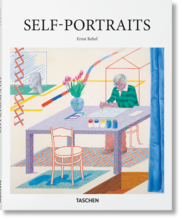More about Self-Portrait with Fur-Trimmed Robe
- All
- Info
- Shop

Contributor
The Yeezus of his day, Dürer’s Self-Portrait could have been more aptly titled I Am a God, partly because of his humongous ego and partly because of how f-a-m-o-u-s he was (and is).
Many have mixed feelings about it. Thomas Hoving, former director of the Met, dubbed it “the single most arrogant, annoying, and gorgeous portrait ever created.” Sure, Dürer talked the talk, but he also definitely walked the walk. The man had mad skills and a selfie game that Kylie Jenner couldn’t even touch—he produced self-portraits at regular intervals throughout his life that depict him as a well-to-do member of society (and a very pretty one at that).
In his last and most famous Self-Portrait, Dürer portrays himself up close and personal with a lavish fur coat and a perm that Louis XIV would envy. It’s important to keep in mind that, at this time, it was extremely abnormal to paint a portrait of yourself facing straight towards the viewer; popular opinion within the genre praised the three-quarter turn, so whenever someone saw this painting, they instantly knew what he was trying to convey. That’s right—this pose, paired with the pseudo-blessing gesture of his hand, would have been seen as 100% Jesus imitation. But Dürer didn’t care. He basically felt like his artistic skill was the stuff miracles were made of.
So, who exactly was he showing of his skill to? This painting was never sold, and wasn't intended for public exhibition. It hung in the artist’s house to show potential VIP clients his prodigious skill as an artist, while allowing Dürer to get lost in his own eyes now and again—a display of vanity to which even Narcissus himself would bow down. He painted this piece with such painstaking detail that his dog actually mistook it for his real master and licked it.
As the “it” boy of the Northern Renaissance, everyone wanted in on Dürer’s fame. And by "everyone" I mean grab-happy forgers who ripped off his original work and sold copies on the down low. The practice of forging his work became an epidemic. Even during his lifetime, he was constantly plagued by copyists who tried to sell knock-off Dürers in lieu of Prada and Gucci handbags. It became such a problem that he even took someone to court for repeatedly copying his prints.
Self-Portrait was not immune to this fandom. Nuremberg artist Abraham Wolfgang Küffner “borrowed” it from the Nuremberg city hall, where it was being kept after Dürer's death, under the guise of wanting to use it to make a personal copy. Instead, he sawed the panel in half, using the newly exposed side to paint a replica of the original. He returned the fake to City Hall and sold the original to a Munich art gallery.
He must have done a pretty good job imitating the hand of the German master; the people of Nuremberg didn't even notice that it was a fake until the original resurfaced and they put two and two together. Apparently they kept the fake up as a conversation piece.
Sources
- Dobrzynski, Judith H. "Staring Dürer in the Face: His Self-Portrait From 1500 Dares You to Turn Away." Judith H. Dobrzynski. March 15, 2008. Accessed July 11, 2017. http://www.judithdobrzynski.com/3013/staring-durer-in-the-face.
- Gambino, Megan. "Ten Famous Intellectual Property Disputes." Smithsonian.com. June 21, 2011. Accessed July 11, 2017. http://www.smithsonianmag.com/history/ten-famous-intellectual-property-….
- Kila, Joris, and Marc Balcells. Cultural Property Crime: An Overview and Analysis on Contemporary Perspectives and Trends. Leiden: Brill, 2015.
- Koerner, Joseph Leo. The Moment of Self-Portraiture in German Renaissance art. Chicago: University of Chicago Press, 1996.
Featured Content
Here is what Wikipedia says about Self-Portrait (Dürer, Munich)
Self-Portrait (or Self-Portrait at Twenty-Eight) is a panel painting by the German Renaissance artist Albrecht Dürer. Completed early in 1500, just before his 29th birthday, it is the last of his three painted self-portraits. Art historians consider it the most personal, iconic and complex of these.
The self-portrait is considered remarkable because of its resemblance to contemporary representations of Christ, which could be interpreted as a stunning feat of either arrogance or blasphemy. The similarities with the conventions of religious painting include the manner in which the artist raises his hands to the middle of his chest as if in the act of blessing, while his direct gaze and the sober and earthy tones are clearly invoking Christ.
Check out the full Wikipedia article about Self-Portrait (Dürer, Munich)


















I still say he looks like Weird Al Yankovic...